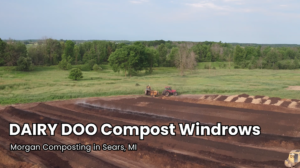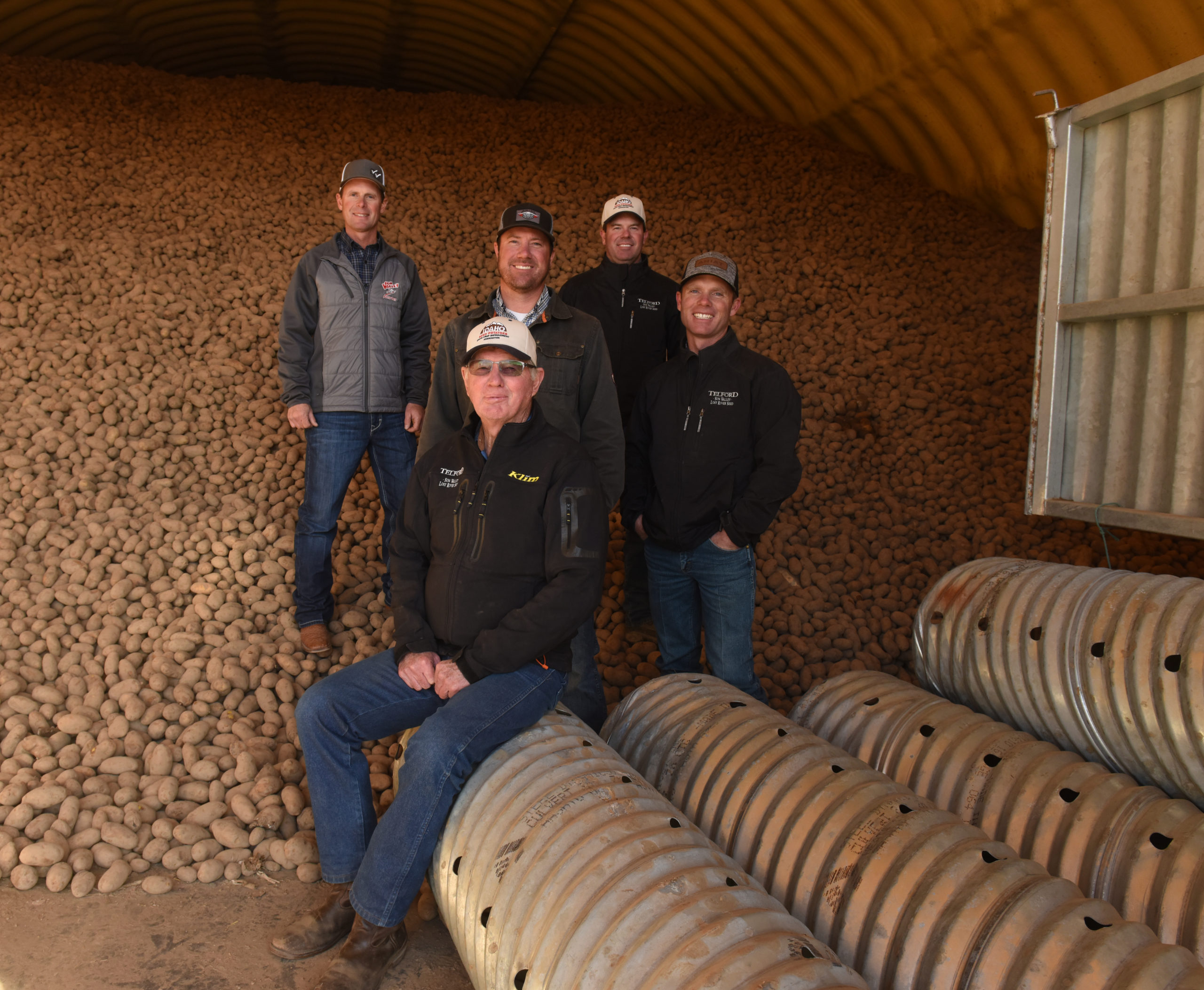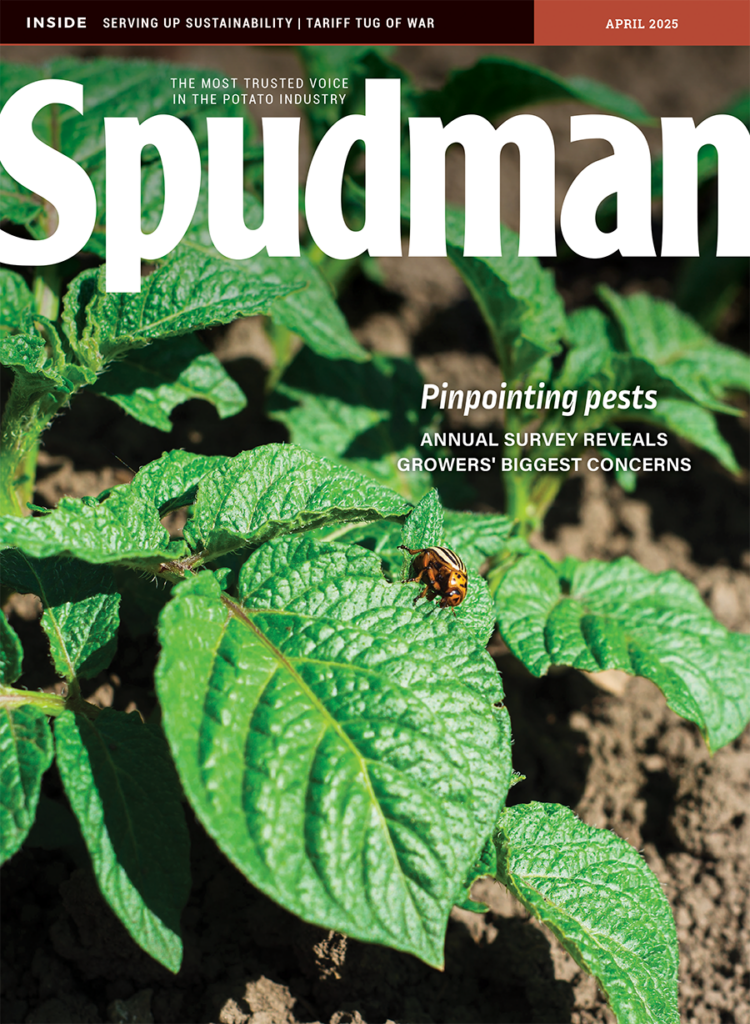
Seed Potato Report 2020: Conditions mostly positive in Central US states
This year has brought a lot of bad with it for Americans, but one bright spot most U.S. seed potato growers can cite is good growing conditions.
Reports from around the U.S. tell of favorable conditions throughout most of the growing season, with average to above-average yields likely in the central and northwestern states. The exception is in the east, where a drought hampered farmers in Maine and New York and will likely result in less-than-desirable yields. Colorado also experienced some hiccups in terms of frost and snow.
Here are reports from the Central U.S. and Great Lakes:
Colorado
The growing season in Colorado was somewhat of a rollercoaster this year.
Planting went well with fairly warm weather and little to no rain or snow. However, we were hit with two frosts, one on June 10 and the other July 1, which definitely set the crop back and made for difficult inspections, requiring more lab testing.
Other than the two frost events, the summer was fairly warm with cool nights, making it ideal for potato production. However, on Sept. 9, just as harvest was getting underway, our seed growers woke up to 12 inches of snow on the ground. This kept everyone out of the field for several days, but things warmed up and the snow melted in just a couple of days. Certified seed growers began killing vines in late July and continued through early August, limiting potential spread of virus by late season aphid flights.
As of Oct. 23, all potato seed acreage has been harvested. Overall, crop yields have hovered around average, but this has varied greatly depending on variety grown. Certified seed growers have submitted their seed samples for the Post Harvest Test. In a normal year, our postharvest test would take place on the North Shore of Oahu. However, due to COVID and other factors, our 2020 postharvest test will mostly take place in a greenhouse environment in Colorado. A postharvest test is required on all certified seed in Colorado, whether it is sold commercially or for recertification. An official 2020 certified seed directory is posted on line at potatoes.colostate.edu/programs/potato-certification-service/crop-directory/. Additional information on Colorado’s Certified Seed can be found at coloradocertifiedpotatogrowers.com.
In 2020, Colorado certified seed potato acreage for sale was down overall from 6,756 acres in 2019 to 6,740 acres in 2020. The 2020 accepted certified acreage after summer field inspections was 6,537 acres. Rejections were primarily the result of PVY/mosaic, with a few rejections caused by blackleg and variety mix. Total potato acreage (both certified and commercial) in the San Luis Valley was 50,923 acres, up from 48,573 acres in 2019.
The 2020 top five certified potato varieties in Colorado were:
- Russet Norkotah (all varieties) — 2,080 acres
- Canela Russet — 817 acres
- Teton Russet — 312 acres
- Reveille — 288 acres
- Centennial Russet — 228 acres
A wide range of potato varieties are certified in Colorado, including multiple varieties of russets, reds, yellows, chippers, fingerlings and specialties.
All seed lots imported into Colorado are required to undergo postharvest testing and a PVYN tolerance of 1.0% is in place for all incoming seed. Also, there is a late blight quarantine in effect for all seed coming into the San Luis Valley. If you are planning on shipping any seed into the valley, this test needs to be conducted by a qualified lab prior to shipment. Check our website for testing specifics at potatoes.colostate.edu/wp-content/uploads/2014/02/Late-Blight-Quar-2014.pdf. — Andrew Houser, manager, Colorado Potato Certification Service
Michigan
The 2020 seed potato crop in Michigan began the season with a 3% decrease in acreage entered for certification. Other than the proprietary varieties, Manistee and Lamoka continue to be the popular chipping varieties in Michigan.
The planting season was timely and uneventful with few delays. The favorable weather led to early and even emergence putting the growing season about a week ahead of normal. We were pleased with the results of our inspections as there were no rejections or class reductions necessary for virus. It was also very encouraging to note we saw no late blight symptoms and very few blackleg symptoms during the inspection process.
Harvest got off to a timely start. Favorable weather for the first two weeks led to great progress early. Rain in late September and early October slowed things a bit, but most farms finished in normal time if not a little early. Fortunately, the temperatures stayed mild so we did not have any frost damage. There was a small amount of water damage in some of the low spots.
In Michigan, we do harvest inspections as part of the certification process. While this inspection is a challenge due to the logistics of actually looking at each lot as it is harvested, it gives us a good idea of what the quality of the crop is as it goes into storage. Although there were some weather challenges through the season, I am very pleased with the overall quality of this season’s crop.
We continue to be on high alert for dickeya by testing symptomatic plants and facilitating laboratory screening of seed lots. This fall, nearly half of all seed lots have been sampled for B.R.R. and dickeya screening. This year we will use the Michigan Dept. of Agriculture and Rural Development lab in East Lansing for the testing.
Probably the biggest change for seed certification here in Michigan is that we will be moving our 2020 crop postharvest test back to South Florida. This decision was made partly for concerns about travel with the COVID issue, but was mostly due to the fact that our cooperator in Hawaii didn’t feel he could accommodate all the states that are currently in Hawaii. Fortunately, we were able to get hooked up with Alger Farms in Florida. The operation has a long history of providing the service for several different states.
This year we will be serologically testing all of our Field Year 1 and 2 lots as well as all samples of varieties that have proven to have latent symptoms for PVY. We continue to adjust our testing and inspection procedures to accommodate the ever-changing virus expression and symptomology. We will sample and test more than half our seed lots for PVY.
Our current board is president Gary Walther; secretary/treasurer Gerald Krueger; and board members Matt Wilkes; Bryan Fischer; Jesse Cousineau; Kelly Turner, Michigan Potato Industry Commission; Jaime Wilbur, Michigan State University, Elizabeth Dorman, MDARD; and Chris Long, Michigan State. — Jeff Axford, executive director, Michigan Seed Potato Association
Minnesota
Seed potato growers in Minnesota applied to certify 6,267.41 acres for the 2020 crop year, an increase from the 6,134 acres in 2019. There were 1,123.53 acres rejected for severe mosaic and not meeting eligibility, resulting in 5,143.88 certified acres. Russet Burbank was the variety with the most acres planted.
The spring brought good weather and near ideal planting conditions throughout the state. Most growers were able to get in the field in late April to early May, with most completing planting by early June. In the Red River Valley, excessive rainfall in the middle of June affected some seed acres. This resulted in some drown-out. Other areas of the state experienced moderate rainfall, and as the summer progressed, growers were optimistic of the anticipated harvest. The Minnesota Department of Agriculture (MDA) inspectors were busy, with three inspections conducted on all certified seed potato lots.
July was warm with ideal growing conditions, followed by a dry August and September. The heat during this period affected some quality and yields. The dry conditions continued into harvest, but some much needed rain proved beneficial to most. Overall, growers reported the harvest produced average yields statewide with good quality.
The MDA Potato Inspection Unit uses a generation system and remains vigilant in detecting potato virus and other disease. The Certified Seed Potato Program continues to honor the USDA Animal and Plant Health Inspection Service memorandum of understanding for Necrotic Virus Management Plan. The global pandemic has affected the farming community in Minnesota, prompting Agriculture Commissioner Thom Petersen to provide guidance for each farm to implement a COVID-19 plan providing safety measures for growers and all who work in the industry.
Due to the COVID-19 global pandemic, the post-harvest winter test will be conducted in Florida this year, rather than Hawaii. The MDA Potato Inspection Unit, along with the Minnesota seed potato growers, would like to thank Ken Bertsch, Kent Sather, and the North Dakota State Seed Department for helping us align with Alger Farms in Homestead, Florida. Samples were collected in October at the office in East Grand Forks while observing social distancing and COVID-19 guidelines. The samples will be planted, and each lot observed visually for stand, vigor, and potato virus. All positive potato virus visual observations are confirmed with a laboratory test. Once complete, the results will be communicated to the growers and industry. For copies of the Minnesota Certified Seed Potato Directory, please visit the Minnesota Department of Agriculture website or call 218-773-4956 to be added to the mailing list. — Eric Byre, Plant Protection Program Supervisor, Minnesota Dept. of Agriculture
Nebraska
It was a fantastic growing season for Nebraska seed potatoes.
Growers reported above-average yields with high quality. Harvest went smoothly and there were no serious losses from early frosts. The annual hailstorms did arrive in mid-August but had little to no effect on yield or quality.
In Nebraska, 7,214.87 acres were entered for certification, with 7,149.57 acres eligible for final certification. Compared to 2019, there was a slight decrease in detectable PVY during summer field inspections, though there was a slight increase in varietal mix. Summer virus tests did not report any findings for PVY.
The top five varieties grown in Nebraska were:
- Russet Norkotah (all strains) — 15%, 1089.48 acres
- Umatilla Russet — 5.8%, 422.56 acres
- Russet Burbank — 5.8%, 420.99 acres
- Lamoka — 5.7%, 416.13 acres
- Atlantic — 2.2%, 157.63 acres
Field year nomenclature is now being used for all seed grown in Nebraska. For example, seed grown as generation nuclear in previous years is now designated as Field Year 1 (FY0). Nebraska is following the lead of other states in standardizing this system.
The 2020 Nebraska postharvest test will be conducted in Homestead, Florida. Planting was scheduled to begin Nov. 5. — Adam Winchester, manager, Potato Seed Certification Association of Nebraska
North Dakota
The 2020 seed potato crop may be one entity that had a somewhat normal season. Most of the North Dakota certified seed potato acreage was planted on time, as weather warmed up in April and May, with just a few growers slightly delayed due to residual moisture from the fall of 2019. Later spring rains helped emergence and stands, but also caused minor drown-out of acreage. The summer overall was recorded as hotter than normal. While temperatures weren’t extremely hot, record consecutive days of higher than normal temperatures were recorded. And there were few late summer rains in dryland areas. Growers waited as long as possible to harvest, hoping for some soaking rains to soften the soils of the dryland fields. None came.
Harvested quantity and quality reflected growth stress. Processing varieties yielded less-than-average with smaller profiles. Dust, clods and dirt clumps rode up the digger chain with the dryland potatoes. Growers expressed concern about bruising and potential dry rot in storage. Red River Valley reds were close to average yields, but size was small and growth cracking was present.
The 2020 crop included 14,546 acres which passed field inspection tolerances for certification, 1,509 acres more than 2019. The top five varieties were:
- Norland strains — 2,435 acres
- Umatilla Russet — 2,289 acres
- Bannock Russet — 1,431 acres
- Dakota Pearl — 1,238 acres
- Ranger Russet — 1,090 acres
The 2020 seed directory can be accessed at our recently remodeled website at www.nd.gov/seed/.
Leaf samples were taken from required seed lots for serological potato virus testing, including PVY and PVX. Laboratory results matched field inspection notes. Inspectors collected random symptomatic blackleg stems and subjected them to lab testing against dickeya. To date, no positives have been confirmed. Several growers will continue dickeya testing on harvested tubers.
Seed growers were proactive with protective fungicides, reducing potential for Phytophthora infestans (late blight). Growers monitored the Blight Alert programs for the region. No late blight was reported. Mosaic vectoring aphid counts were tracking slightly above the previous year slightly increasing the vector risk factor, especially in the dryland seed growing area. Again, growers were strongly encouraged to use protective oils and insecticides through the growing season and vine kill as early as possible.
North Dakota State Seed Department tissue culture and greenhouse staff harvested a record minituber crop in June and October. These minitubers will supply North Dakota seed growers with the first field year crop of 2021, creating a clean seed source for crops in future years. Nearly all early field generation seed lots in North Dakota are planted in very isolated areas in the western part of the state. Inspection results indicated freedom from viruses. Threat by aphid populations, mosaic or late blight inoculum was very low and not observed. These seed lots provide the basis for future North Dakota seed production.
The cycle of seed potato certification continues as North Dakota certified seed growers randomly select tubers from 2020 crop seed lots requiring a postharvest test planted in Homestead, Florida. Results from this stage of testing will determine seed lots eligible for certification for the future 2021 crop. — Kent Sather, director, potato programs, North Dakota State Seed Dept.
Wisconsin
The year will be remembered for both ups and downs, but for seed potatoes in Wisconsin, it will be mostly positive.
Spring shipping was strong, total hundredweight shipped through May was vigorous and this is likely due to chip and fresh sectors maintaining or having increased demand from COVID-19. The seed used for the regional fry processing sector represents only a small percentage of Wisconsin’s seed certification program.
Spring planting always presents challenges, but the majority of seed was planted within the normal planting window of May. In 2020, a total of 9,344 acres were planted and entered into certification, up from 9,267 in 2019, a 1% increase. June growing conditions were dryer than normal and ended with unseasonably hot and humid weather, potentially having an effect on how varieties set.
Upcoming varieties include Plover Russet (W9133-1rus), which was a recently named release from the SpudPro collaboration between University of Wisconsin (UW) Potato Breeding and the seed industry. It is an early russet with better shape than Goldrush.
Another upcoming UW variety Red Prairie (W8405-1R) has also seen acreage increases, it is a high yielding red variety with shallow eyes, round to oblong shape. Other varieties with growing interest are Mackinaw (chipper), a recent Michigan State release, Reveille russet (Texas A&M), and Caribou russet (developed by Maine and licensed/controlled through Maine Potato Board). Interest in Manistee (chipper) has remained steady with a 7% gain.
Wisconsin seed growers chose to grow slightly fewer Lamoka, down 7%, and Silverton, down 9%, as major varieties.
Noteworthy for this summer’s production season was a heavy rain event July 26 that affected growers in Langlade County, with precipitation totals in excess of 5 inches in most of the area. Areas did suffer from drown-outs, but the area dried quickly following the deluge. Lenticels shrunk and tubers remained in good health. Some vine damage brought on white mold and aerial blackleg for the final weeks of the season. No Late blight was found in our seed production area.
Tuber numbers per hill were high in some varieties and low in others, presenting vine-kill planning and fertilization challenges to manage through the season due to rain events in July. Overall the tuber numbers were higher across most varieties and is reflected in smaller seed harvested this fall.
Harvest was essentially complete by mid-October, with some of the fairest harvest conditions in recent memory. Harvests of 2019 and 2018 were very challenging due to rain and freezing events.
COVID-19 has changed our postharvest testing plans, however, we remain committed to our seed certification rules (ATCP156) and the support of ELISA testing. Our ability to plant and conduct readings in Hawaii has changed, and with it putting on hold our ongoing cooperation with University of Hawaii for ELISA testing. Our planned location for the grow-out is southern Florida. While we were testing over 500 seed lots with ELISA in addition to our visual inspections, we will be testing about half of the material we have been in recent years at our lab based at UW-Madison. — Alex Crockford, director, Wisconsin Seed Potato Certification Program














